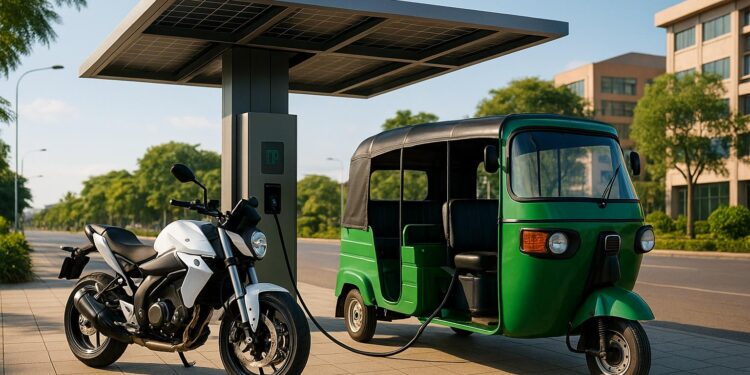Uganda is transforming its transportation landscape. The country has updated its e-mobility policy to include all electric two- and three-wheelers under a unified framework. This change simplifies regulations, encourages local manufacturing, and supports the transition to cleaner, more efficient vehicles.
Key Highlights:
- Unified Rules: Covers electric motorcycles, scooters, tricycles, and motor-assisted bicycles.
- Incentives for Manufacturers: Includes a 10-year income tax exemption, VAT waivers, and import duty benefits for local assembly.
- Charging Infrastructure Growth: Over 200 charging and battery swap stations installed nationwide, with more planned.
- Cost Savings for Users: Lower operating costs, reduced maintenance, and financial support for buyers.
- Environmental Benefits: Zero tailpipe emissions and quieter operation for better urban living.
This policy supports manufacturers, buyers, and the broader push for cleaner transportation in Uganda. With clear goals and financial incentives, it’s setting the stage for a future where electric mobility is the norm.
Electric motorbikes gain ground in Uganda amid fuel concerns
How the Policy Affects Manufacturers and Importers
The updated e-mobility policy has brought clarity and fresh opportunities for manufacturers and importers. By addressing uncertainties and introducing streamlined processes, it paves the way for consistent compliance and growth in the electric vehicle sector.
New Compliance Requirements
Manufacturers and importers now face standardized safety certifications that apply to all electric motorcycles and tricycles. These regulations focus on key areas like battery performance, electrical safety, and durability testing. The introduction of a unified certification process simplifies administrative tasks while prioritizing higher safety and performance standards across all vehicle types.
Support for Local Manufacturing
The policy goes beyond compliance by actively encouraging domestic production. To strengthen local manufacturing, the government has introduced fiscal incentives designed to attract and support investment in electric 2- and 3-wheeler production. One of the standout measures is a ten-year income tax exemption for companies setting up local manufacturing operations. Industry leaders have highlighted these efforts:
"The Ugandan Government has implemented vital fiscal incentives, including a Ten-Year Income Tax Exemption for EV manufacturers and VAT exemptions for locally manufactured EVs and charging equipment."
These fiscal measures, including VAT exemptions and tax breaks, have significantly boosted local production capabilities. Current production capacity has reached 10,000 units annually, with up to 40% local content. Investments in production and battery pack development have surpassed $160 million between 2018 and 2024, reflecting the transformative impact of the policy.
User Benefits: Cost Savings and Environmental Impact
The updated e-mobility policy brings clear advantages for individuals and businesses opting for electric two- and three-wheelers. These benefits translate into long-term savings and meaningful contributions to a cleaner environment.
Lower Operating Costs
Electric vehicles are far more economical to operate compared to their gasoline counterparts. Their energy costs are significantly lower, and their simpler drivetrains mean fewer parts to maintain or repair. Advancements in battery technology have also extended the lifespan of these vehicles, with leasing programs helping to minimize replacement expenses. On top of that, insurance providers often offer better rates for electric vehicles due to their enhanced safety features, further reducing ownership costs.
Reduced Emissions and Pollution
Switching to electric vehicles isn’t just about saving money – it’s also about cleaner air and a healthier environment. Electric two- and three-wheelers produce zero direct tailpipe emissions, which is a game changer for urban areas grappling with air quality issues. These vehicles also have a smaller carbon footprint compared to traditional gasoline models. As Uganda continues to expand its renewable energy resources, the environmental benefits of electric vehicles are poised to increase even further. Additionally, the quiet operation of electric motorcycles reduces noise pollution, making city life more pleasant. Their efficient motors generate less waste heat, which can also help in moderating urban temperatures.
Better Access to Charging Infrastructure
Cost savings and environmental perks are only part of the equation – convenient charging options are crucial for wider adoption. Thanks to the revised policy, Uganda’s charging infrastructure is growing rapidly. Public charging stations are becoming more common in major cities and along key transportation routes, making it easier for users to keep their vehicles powered. For commercial users, battery swapping services are available to minimize downtime. Residential charging solutions have also improved, offering overnight recharging and faster options with dedicated units. Many workplaces are now investing in charging facilities to support employees who commute via electric vehicles. On-demand mobile charging services further enhance convenience, providing emergency charging or battery swaps when needed, ensuring drivers are never left stranded.
sbb-itb-7bab64a
Government Support Programs and Financial Help
Uganda is ramping up its efforts to support the entire e-mobility ecosystem, offering a mix of financial incentives and infrastructure investments to speed up the adoption of electric 2- and 3-wheelers.
Tax Breaks and Subsidies
To encourage local assembly, the government has introduced several tax incentives. Companies assembling electric two-wheelers domestically benefit from full import duty exemptions on essential parts. Additionally, they enjoy Value-Added Tax (VAT) exemptions on key components and a five-year income tax holiday, enabling them to reinvest profits during their early growth stages.
"The incentives are designed to encourage investment and local manufacturing while curbing the importation of fully built fuel-powered motorcycles", stated Evelyn Anite, State Minister for Investment.
This policy marks a shift from earlier strategies. For instance, in early 2024, import duties on fully built electric vehicles were waived. However, this decision was reversed within months to prioritize local manufacturing. Companies like Spiro are already expanding their local assembly operations to align with this focused approach.
Charging Network Development
A key part of Uganda’s strategy is a 10-year infrastructure development plan, launched in December 2024, which includes significant investments in charging facilities. This plan embraces a variety of technologies, such as battery swapping, plug-in, contact, and wireless charging systems.
Currently, Uganda has at least 50 charging stations installed by the Ministry of Energy and Mineral Development, with the private sector operating over 150 motorcycle battery swapping stations nationwide. The goal is to create both intra-city and inter-city charging networks, addressing range anxiety and making electric vehicles more practical for everyday use.
"Government and private sector must plan cohesively to create reliable public charging points and fast charging stations across the nation to catalyze the growth of EVs and reduction in EV prices", according to the STI Secretariat.
Funding for this expansion comes from multiple sources, including international climate funds like the Green Climate Fund and the Climate Investment Funds. Additional financing is provided by green bonds from organizations such as the African Development Bank and the World Bank, as well as domestic government bonds and private sector contributions. These investments are central to Uganda’s vision for cleaner and more dependable urban mobility.
Job Training and Skills Development
Recognizing the need for a skilled workforce, the government is rolling out training programs focused on EV maintenance, battery technology, and charging station operations.
The emphasis on local assembly is expected to create manufacturing jobs, reduce reliance on imported vehicles, and boost local expertise. These training initiatives target both current automotive workers transitioning to EV technologies and new entrants to the sector.
"The Government of Uganda commits to implementing these interventions and policy measures over the next 10 years", said the STI Secretariat.
How to Comply with the New Policy Requirements
To successfully adapt to Uganda’s new e-mobility framework, businesses and individuals need to follow specific steps. These guidelines outline what businesses must do to enter the market and how buyers can embrace electric vehicle (EV) adoption.
Compliance Steps for Businesses
For businesses, Uganda offers incentives designed to encourage growth in the e-mobility sector, including access to the country’s annual assembly capacity of 10,000 electric vehicles.
Key Requirements for Market Entry:
- Local Manufacturing: Establish manufacturing operations within Uganda to qualify for a 10-year income tax holiday. This allows businesses to reinvest profits during their initial growth phase.
- Import Benefits: Source key components internationally and take advantage of import duty waivers on these parts.
- Tax Exemptions: Benefit from VAT exemptions on locally produced electric vehicles and charging stations, reducing overall production costs.
- Technical Standards: Ensure compliance with Uganda’s safety and performance requirements for electric 2- and 3-wheelers, including battery efficiency and charging compatibility.
- Battery Production: Invest in local battery manufacturing, as batteries represent 60% of an electric vehicle’s total value.
These measures are part of Uganda’s broader push to create a sustainable urban transport system.
Guide for Electric Vehicle Buyers
Individual buyers are supported by Uganda’s infrastructure and financing options, making the switch to electric vehicles more accessible. With over 12,500 electric motorcycles and 1,500 electric bicycles already in use across the country, the foundation for adoption is well-established.
- Vehicle Selection and Financing: Buyers should explore loan programs tailored for electric motorcycles. These financing options often include remote tracking systems, which reduce risks for lenders and increase affordability.
- Charging Access: Uganda boasts an extensive network of charging and battery swap stations, simplifying day-to-day vehicle use.
- Maintenance and Operation: Electric vehicles require less frequent servicing due to fewer moving parts and the absence of oil changes. Buyers should learn about proper battery care, ideal charging schedules, and where to find authorized service centers.
- Registration and Documentation: Registering an electric vehicle involves standard vehicle registration steps, along with additional paperwork for EV-specific components like batteries. Buyers should confirm their vehicle meets Uganda’s technical standards and is appropriately certified.
These steps make the transition to electric vehicles smoother and align with Uganda’s goals for cleaner, more sustainable urban mobility.
Electric vs. Petrol Vehicle Comparison
When deciding between electric and petrol 2- and 3-wheelers, understanding their differences is crucial:
| Aspect | Electric Vehicles | Petrol Vehicles |
|---|---|---|
| Operating Costs | Lower electricity costs and minimal maintenance | Higher fuel expenses with regular oil changes and frequent servicing |
| Environmental Impact | Zero direct emissions, improving air quality | Emits pollutants that contribute to air pollution |
| Infrastructure | Over 390 battery swap stations and a growing charging network | Widespread and established fuel station network |
| Initial Investment | Higher upfront cost, offset by government incentives and favorable financing options | Lower purchase price, but no special incentives |
| Range and Refueling | Quick battery swaps; range suited for urban travel | Fast refueling and generally longer range |
| Maintenance | Fewer moving parts, reducing service needs | Requires regular engine maintenance and has higher wear-and-tear costs |
Performance Characteristics: Electric vehicles shine in urban settings with instant torque and quiet operation, while petrol vehicles are better suited for long-distance travel or areas lacking charging infrastructure.
Total Cost of Ownership: Despite higher initial costs, electric vehicles are often more economical over time. Government incentives, reduced operating expenses, and lower maintenance make EVs a smart financial choice for many buyers. These advantages highlight the economic and environmental benefits driving Uganda’s e-mobility strategy forward.
What This Means for Uganda’s Transportation Future
Uganda’s updated e-mobility policy is reshaping the way people think about urban transportation. By including all 2- and 3-wheelers in its plans, the country is paving the way for broader adoption of electric vehicles across the region.
This policy doesn’t just stop at promoting electric mobility – it creates a supportive environment for everyone involved. For manufacturers, tax breaks and other incentives aim to encourage local production, potentially making electric vehicles more competitive with traditional gas-powered options. For consumers, the shift promises long-term savings and cleaner air in cities. With improved infrastructure, electric vehicles are becoming a practical choice for daily commutes, further highlighting the benefits of reduced costs and emissions.
The policy’s impact goes beyond transportation. It’s expected to stimulate economic growth by encouraging local investment in battery production and vehicle assembly. By focusing on building local expertise, Uganda could create skilled jobs, reduce its dependence on imports, and align with its environmental and public health goals. These efforts strengthen the country’s vision for sustainable urban transport.
Uganda’s strategy showcases how transportation can evolve by balancing economic progress with environmental responsibility. By addressing the needs of manufacturers, consumers, and the environment, this revised e-mobility framework sets a standard for sustainable urban transport. It not only supports Uganda’s goals but also offers a model that other nations in the region could follow.
FAQs
What incentives does Uganda’s updated e-mobility policy offer to local manufacturers of electric two- and three-wheelers?
Uganda’s revised e-mobility policy introduces a range of incentives designed to boost local manufacturing of electric two- and three-wheelers. Among the highlights are a 10-year income tax holiday for manufacturers, VAT exemptions on locally produced electric vehicles and charging infrastructure, and import duty waivers on critical parts and components.
These initiatives are geared toward lowering production costs, encouraging the use of cleaner transportation options, and fostering the development of Uganda’s e-mobility sector.
How is Uganda’s growing charging infrastructure helping to boost electric vehicle adoption, and what types of chargers are being introduced?
Uganda is steadily building up its charging infrastructure, making it easier for people to embrace electric vehicles (EVs). By addressing concerns like range anxiety and ensuring convenient access to charging points, the country is setting the stage for wider EV adoption. The government has some ambitious plans in motion, starting with the launch of its first public EV charging station in Kampala, scheduled for early 2025. Looking ahead, there’s a goal to establish a network of 3,500 public charging stations by 2040, working in collaboration with private companies.
To meet the diverse needs of EV users, Uganda is rolling out a mix of fast DC chargers and standard chargers. Fast chargers, like the ones recently installed at Amber House in Kampala, are designed for quicker charging times, making them ideal for those on the go. On the other hand, standard chargers offer a more budget-friendly option. This expanding network not only supports a growing number of EV users but also aligns with efforts to reduce emissions and encourage cleaner, more sustainable transportation across the country.
What are the environmental and financial benefits of switching to electric two- and three-wheelers in Uganda?
Switching to electric two- and three-wheelers in Uganda brings both eco-friendly and economic benefits. These vehicles contribute to reducing carbon emissions, which means cleaner air, quieter streets, and progress toward Uganda’s sustainability goals.
From a financial perspective, electric vehicles are much cheaper to run and maintain. Their total cost of ownership is roughly 60% of what you’d spend on a diesel-powered counterpart. Plus, energy expenses are only about 20–22% of the cost of gasoline or diesel. For individuals and businesses alike, this translates into significant long-term savings.
Related Blog Posts
- Top 5 Electric Vehicles Gaining Popularity in Uganda
- Uganda’s Localization Policies in Automotive Manufacturing
- Uganda bans diesel bus imports to boost local manufacturing
- Kenya’s EV push puts pressure on Uganda to move faster




